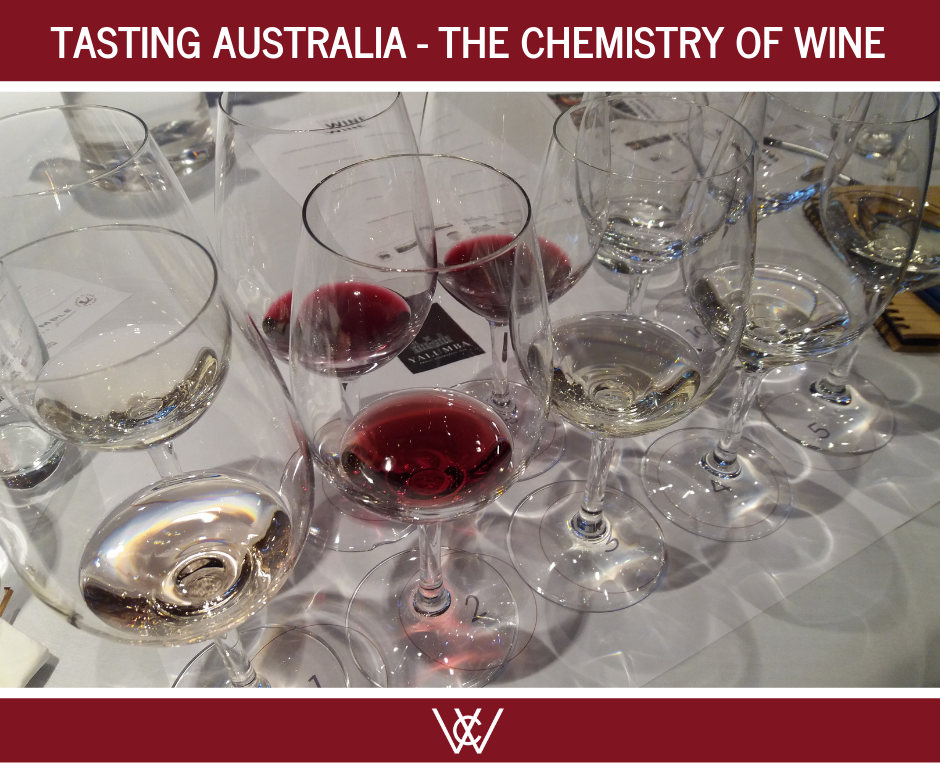I love a good aged Riesling with just a touch of TDN*, and I can get pretty happy from a bit of pyrazine in a nice Cabernet Sauvignon**. Not sure what I am talking about? You must have missed out on the Tasting Australia Event ‘The Chemistry of Wine’.
I had the pleasure of listening to two absolute guns in the wine industry discussing the vast array of aromas and flavours you can find in your glass of wine, with a little bit of extra education. Kerry Wilkinson, professor of Oenology at the University of Adelaide, and Louisa Rose, Chief winemaker at Yalumba; both bring an incredible tasting palate, a good dose of humour and a bucket load of intelligence to the table, as well as too many science and industry accolades to even start mentioning here. The mix of their experience in their respective fields made it a complete, well-rounded and incredibly enjoyable event for everyone in the audience; the science geek, the winemaker, the wine connoisseur and also the “I am just here to drink the wine”-listener.
So – in a nutshell, what you missed on the scientific level if you were not there:
Do not worry if you cannot taste certain flavours in wine and everyone around you seems to be happily tasting dark chocolate, Ribena and pepper: it might be your parents fault (well, your genetic make-up). The discovery of the compound Rotundone, which gives Shiraz that beautiful peppery aroma, also came with the finding that twenty percent of the population cannot smell this. Which brings us to key message number 2…
You know you can smell certain aromas in your glass and now you wonder when in the winemaking process vanilla, pencil shavings and tropical fruit are added: stop! Winemakers are not bringing in blocks of Cadbury nor are they getting school kids to donate their pencil shavings to add to oaky aromas – these compounds are present as their own flavour and aroma molecules in the grape, develop during fermentation by interaction with yeast, or are taken up by time in a barrel.
Remember those chicken-wire chemical structures from high school? Those things make up 2% of your wine, with the other 98% being water and alcohol, and give you a complex mixture to give you wine aroma, flavour, acid and mouthfeel.
A range of anthocyanins, tannins and phenolics are used in wine chemistry labs to describe why your wine looks, tastes and smells the way it does. Interactions between these fancy-named compounds determine if you are looking at a bright or dull-coloured wine (anthocyanins at work), if a wine feels smooth or rough (like fur on your teeth, due to tannins) and if you take a second sniff or now (phenolics). A winemaker does not necessarily have to analyse all of these compounds daily, but does need to understand what can affect the outcome here – different levels of acidity for example can cause a wine to not only taste different, but also look and feel!
The best thing about this chemistry class though? That must have been the examples rolled out to really get an understanding of the differences you can find with only small changes in winemaking, grape growing and ageing of what is in your glass. A beautiful tasting took the participants through two different styles of Yalumba Grenache, Chardonnay from two different vineyards and some cracking Australian sparkling wine.
I bet even the biggest class-clown would be paying attention in chemistry if it was Kerry and Louisa introducing them to the exciting science you can find in your glass.
*TDN: trimethyl dihydronapthalene, the compound causing a petrol or kerosene aroma in aged Rieslings
**pyrazine: the compound found in wines that smell vegetal, think capsicum and tomato leaf.
Written by Dr. Lieke van der Hulst who is the WCA Wine Media Cadet in 2018 and is also an avid wine enthusiast, science lover, and communicator.

